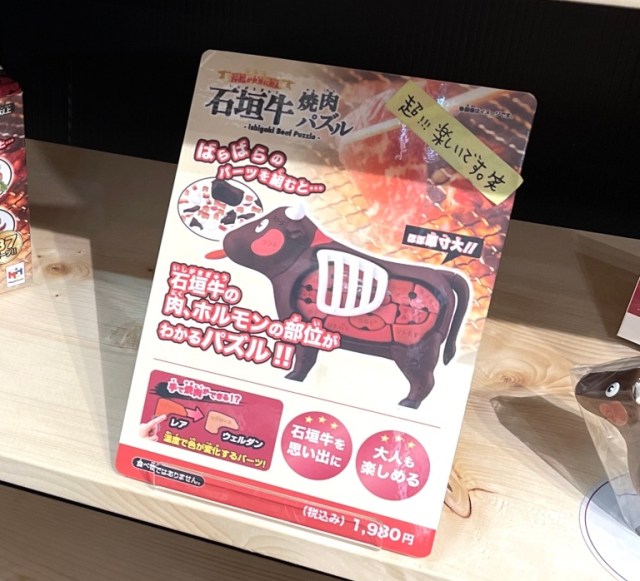
Can’t tell your sotomomo from your sankakubara? This puzzle is here to help!
Yakiniku seems like it should be the easiest thing in the world to order. It’s all just strips of beef, which you cook yourself on the in-table grill, right?
Sure, but it’s not like the restaurant just gives you a random assortment of beef slices. Instead, you order specific cuts of beef, so in order to get what you want you need to know what part of the cow each cut comes from, and also what they’re called in Japanese.
So today, we’re brushing up on our yakiniku vocabulary with the help of this cute and quirky 3-D puzzle we picked up on Ishigakijima Island in Okinawa.
Called the Ishigaki Beef Puzzle, it set us back 1,980 yen (US$17.20), but we figured that’s a worthwhile investment if it leads to more delicious yakiniku meals in our future.
Each meat piece has its name written on it in phonetic katakana Japanese text, so let’s start off by listing them and their English equivalents.
From left to right, starting with the top row and then moving down, those are:
1. kata rosu / カタロース: shoulder roast
2. maebara / マエバラ: chuck roast
3. ribu rosu / リブロース: ribeye roast
4. hire / ヒレ: tenderloin
5. nekku / ネック: neck
6. saroin / サーロイン: sirloin
7. nakabara ナカバラ: boneless short rib (also sometimes called jokarubu / 上カルビ)
8. ranpu, ichibo / ランプ, イチボ: upper rump, lower rump
9. ude / ウデ: shoulder clod
10. sankakubara / サンカクバラ: chuck short ribs
11. karubi / カルビ: boneless short rib (situated lower nakabara)
12. sotobara / ソトバラ: short plate
13. maru, uchimomo / マル, ウチモモ: round, top round
14. sotomomo / ソトモモ: bottom round
As we started to put the pieces together, we quickly learned that this puzzle is incredibly difficult, and not just because the pieces are tiny.
The bigger problem than the small pieces is that unlike with, say, a jigsaw puzzle, the Ishigaki Beef Puzzle’s packaging doesn’t have picture of the completed puzzle. So while we had the outer cow put together quickly, we were pretty lost on what to do next.
▼ We know this should be filled with meat. We’re just not sure how.
Some of the cuts’ names, though, are hints in and of themselves. Nakabara, for example, literally means “inner belly,” so it makes sense that it goes at the very center. And with sotobara translating directly as “outer belly,” we figured that would be somewhere closer to the bottom of the cow. Eventually, with the help of a little online research, we were able to get everything in place, and it looked like this.
Loosely grouped into three rows, from left to right those are:
●Top row: kata rosu, ribu rosu, hire, ranpu, ichibo
● Middle row: maebara, sankakubara, nakabara, maru, uchimomo
● Bottom row: ude, sotobara, karubi, sotomomo
Once you know what the cut you want is called, ordering it in a restaurant is as easy as saying “kudasai” (“please”) after the cut’s name.
Oh, and since this is a yakiniku puzzle, you’re supposed to “cook” the assembled version to your liking using a hair dryer, with the pieces turning from raw-red to pseudo-grilled brown as they heat.
By the way, you may have noticed that the box says the puzzle actually has 37 parts. In addition to the cuts of meat, there are a few incidentals like the cow’s tongue and rib bones…
…but there’s also a complete set of horumon, organs and other non-meat parts of the cow that are also offered at yakiniku restaurants, that go underneath the puzzle’s meat cuts.
But if you’ll excuse us, all this playing with food toys has us feeling very hungry, and now that we know what each cut of beef is called, we feel the need to run full-speed to our nearest yakiniku restaurant.
Photos ©SoraNews24
● Want to hear about SoraNews24’s latest articles as soon as they’re published? Follow us on Facebook and Twitter!
[ Read in Japanese ]

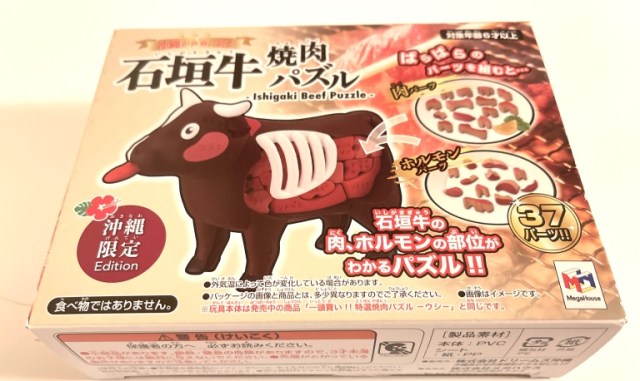
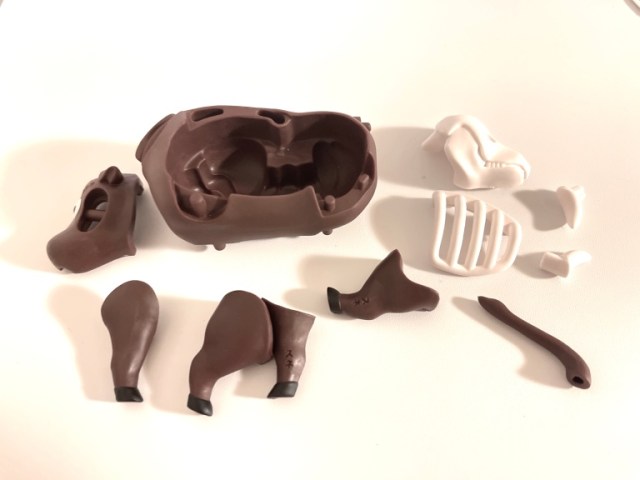
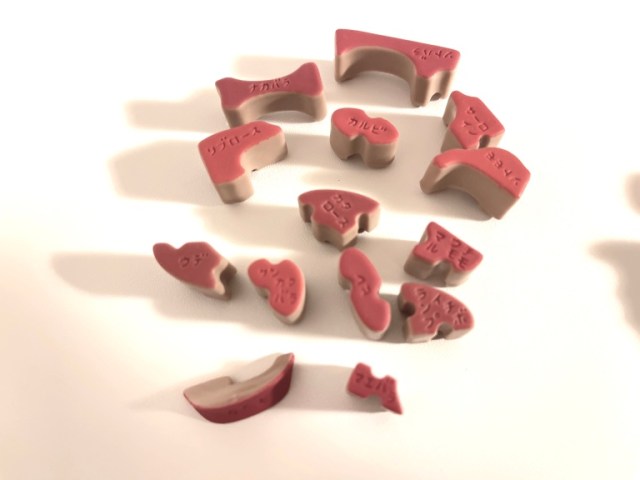
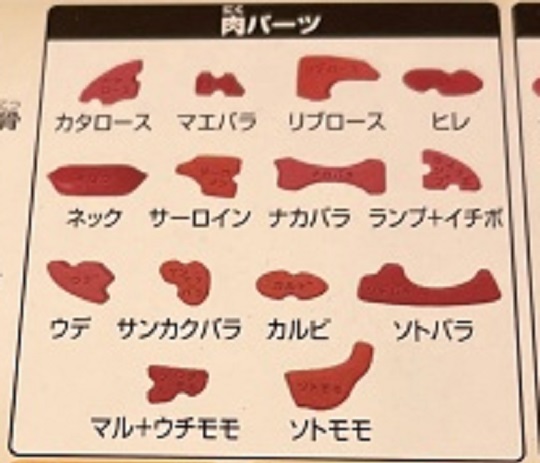
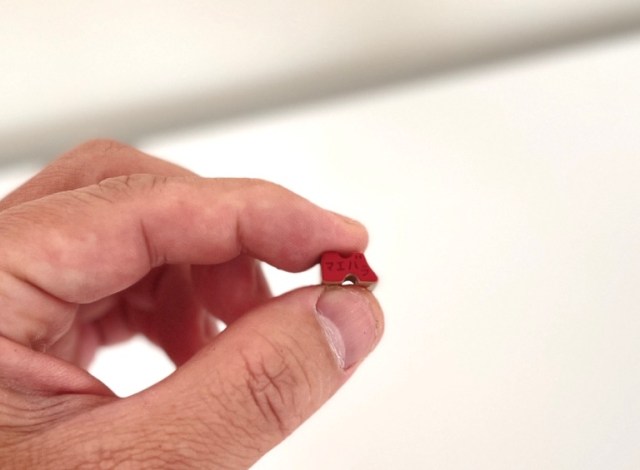

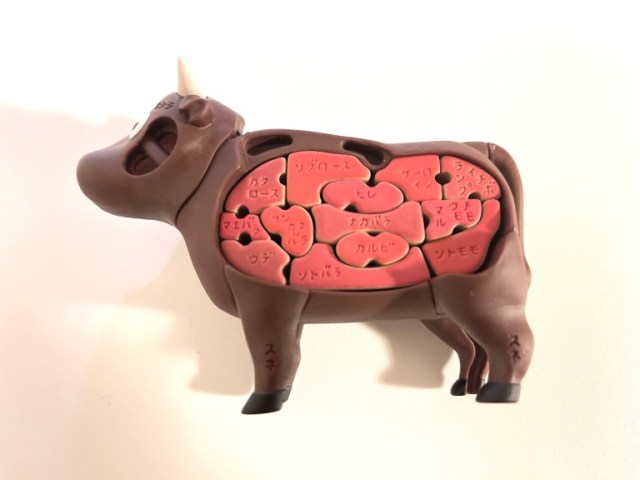
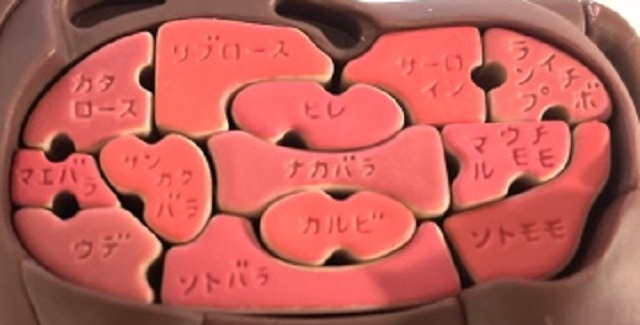
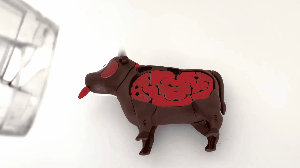
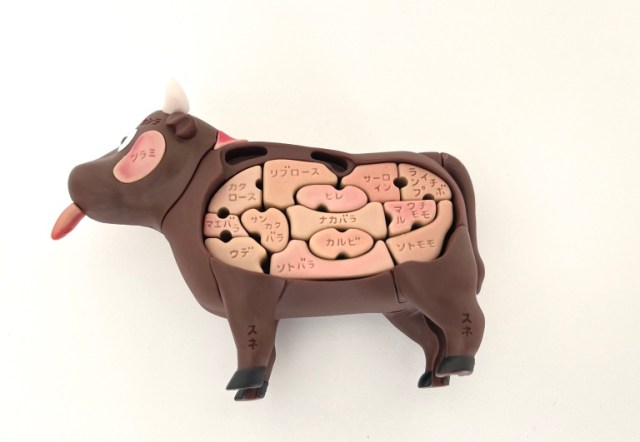
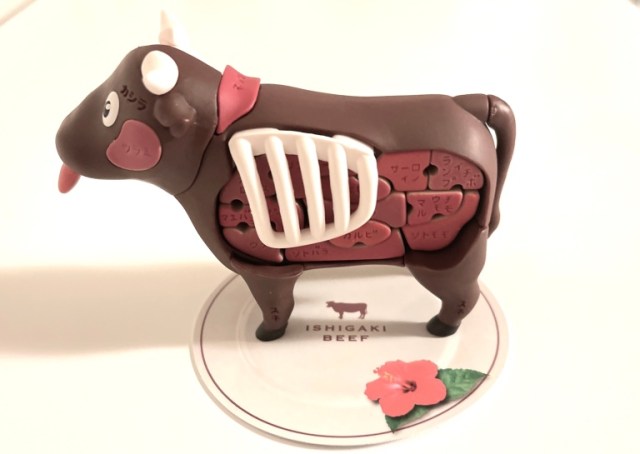
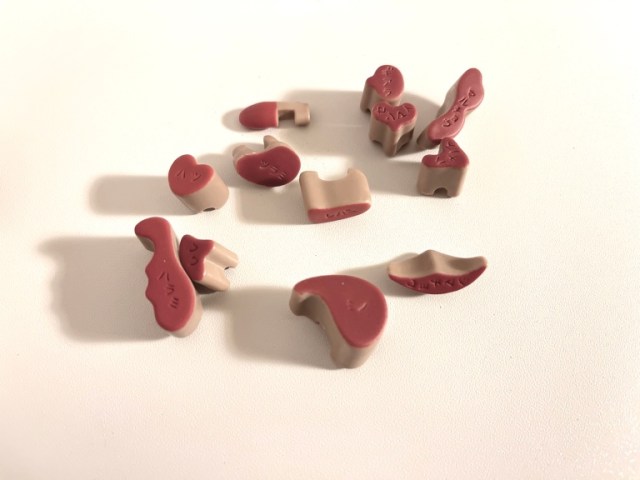
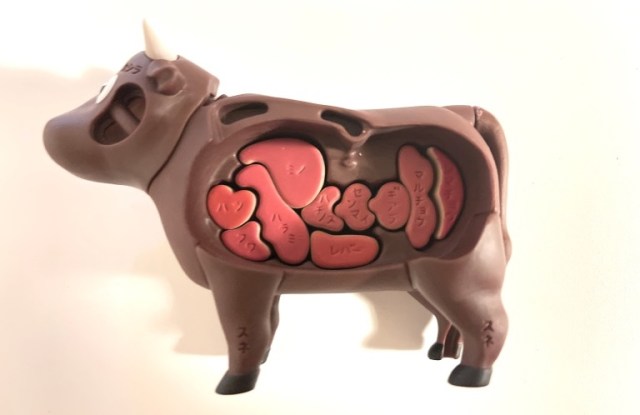
 Tokyo restaurant with two-year wait now offers random meat packs from vending machine【Taste test】
Tokyo restaurant with two-year wait now offers random meat packs from vending machine【Taste test】 We visit a conveyor belt BBQ offering Japan’s best beef at only a fraction of the price【Pics】
We visit a conveyor belt BBQ offering Japan’s best beef at only a fraction of the price【Pics】 All-you-can-eat yakiniku in Shinjuku for less than 10 bucks!
All-you-can-eat yakiniku in Shinjuku for less than 10 bucks! Yakiniku rice burger: A bento boxed lunch you can eat with one hand
Yakiniku rice burger: A bento boxed lunch you can eat with one hand Solo sukiyaki! Cook-in-the-counter hot pot is newest way to treat yourself to great food in Tokyo
Solo sukiyaki! Cook-in-the-counter hot pot is newest way to treat yourself to great food in Tokyo Bad tourist manners at Mt Fuji Lawson photo spot prompts Japanese town to block view with screens
Bad tourist manners at Mt Fuji Lawson photo spot prompts Japanese town to block view with screens Foreigner’s request for help in Tokyo makes us sad for the state of society
Foreigner’s request for help in Tokyo makes us sad for the state of society McDonald’s Japan’s new pancake pie is a taste sensation
McDonald’s Japan’s new pancake pie is a taste sensation Two things to do, and two things not to do, when leaving a traditional Japanese inn
Two things to do, and two things not to do, when leaving a traditional Japanese inn One of Japan’s oldest castles now lets travelers spend night on the grounds, drink in its keep
One of Japan’s oldest castles now lets travelers spend night on the grounds, drink in its keep Studio Ghibli unveils new goods that tip the hat to The Cat Returns
Studio Ghibli unveils new goods that tip the hat to The Cat Returns FUK COFFEE?!? Japanese cafe has a perfectly innocent reason for its startling-looking name
FUK COFFEE?!? Japanese cafe has a perfectly innocent reason for its startling-looking name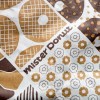 Mister Donut’s new Kyoto roasted green tea donut is a mess…in the best possible way
Mister Donut’s new Kyoto roasted green tea donut is a mess…in the best possible way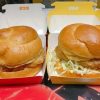 Who wins in a battle of McDonald’s and Komeda Coffee’s chicken tatsuta burgers?【Taste test】
Who wins in a battle of McDonald’s and Komeda Coffee’s chicken tatsuta burgers?【Taste test】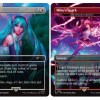 Hatsune Miku comes to Magic: The Gathering with official crossover cards【Photos/Video】
Hatsune Miku comes to Magic: The Gathering with official crossover cards【Photos/Video】 Japanese ramen restaurants under pressure from new yen banknotes
Japanese ramen restaurants under pressure from new yen banknotes Red light district sushi restaurant in Tokyo shows us just how wrong we were about it
Red light district sushi restaurant in Tokyo shows us just how wrong we were about it McDonald’s new Happy Meals offer up cute and practical Sanrio lifestyle goods
McDonald’s new Happy Meals offer up cute and practical Sanrio lifestyle goods Tokyo Tsukiji fish market site to be redeveloped with 50,000-seat stadium, hotel, shopping center
Tokyo Tsukiji fish market site to be redeveloped with 50,000-seat stadium, hotel, shopping center Japanese city loses residents’ personal data, which was on paper being transported on a windy day
Japanese city loses residents’ personal data, which was on paper being transported on a windy day Beautiful Red and Blue Star luxury trains set to be Japan’s new Hokkaido travel stars
Beautiful Red and Blue Star luxury trains set to be Japan’s new Hokkaido travel stars Ghibli Park now selling “Grilled Frogs” from food cart in Valley of Witches
Ghibli Park now selling “Grilled Frogs” from food cart in Valley of Witches New definition of “Japanese whiskey” goes into effect to prevent fakes from fooling overseas buyers
New definition of “Japanese whiskey” goes into effect to prevent fakes from fooling overseas buyers Our Japanese reporter visits Costco in the U.S., finds super American and very Japanese things
Our Japanese reporter visits Costco in the U.S., finds super American and very Japanese things All-you-can-drink Starbucks and amazing views part of Tokyo’s new 170 meter-high sky lounge
All-you-can-drink Starbucks and amazing views part of Tokyo’s new 170 meter-high sky lounge More foreign tourists than ever before in history visited Japan last month
More foreign tourists than ever before in history visited Japan last month New Pokémon cakes let you eat your way through Pikachu and all the Eevee evolutions
New Pokémon cakes let you eat your way through Pikachu and all the Eevee evolutions Disney princesses get official manga makeovers for Manga Princess Cafe opening in Tokyo
Disney princesses get official manga makeovers for Manga Princess Cafe opening in Tokyo We try out “Chan Ramen”, an underground type of ramen popular in the ramen community
We try out “Chan Ramen”, an underground type of ramen popular in the ramen community Sales of Japan’s most convenient train ticket/shopping payment cards suspended indefinitely
Sales of Japan’s most convenient train ticket/shopping payment cards suspended indefinitely Sold-out Studio Ghibli desktop humidifiers are back so Totoro can help you through the dry season
Sold-out Studio Ghibli desktop humidifiers are back so Totoro can help you through the dry season Japanese government to make first change to romanization spelling rules since the 1950s
Japanese government to make first change to romanization spelling rules since the 1950s Ghibli founders Toshio Suzuki and Hayao Miyazaki contribute to Japanese whisky Totoro label design
Ghibli founders Toshio Suzuki and Hayao Miyazaki contribute to Japanese whisky Totoro label design Doraemon found buried at sea as scene from 1993 anime becomes real life【Photos】
Doraemon found buried at sea as scene from 1993 anime becomes real life【Photos】 Tokyo’s most famous Starbucks is closed
Tokyo’s most famous Starbucks is closed One Piece characters’ nationalities revealed, but fans have mixed opinions
One Piece characters’ nationalities revealed, but fans have mixed opinions We asked a Uniqlo employee what four things we should buy and their suggestions didn’t disappoint
We asked a Uniqlo employee what four things we should buy and their suggestions didn’t disappoint Tokyo food budget savior: All-you-can eat yakiniku, every night for less than four bucks
Tokyo food budget savior: All-you-can eat yakiniku, every night for less than four bucks Bulky boxes of wagyu beef can be yours with Japan’s rental frying pan/meat subscription service
Bulky boxes of wagyu beef can be yours with Japan’s rental frying pan/meat subscription service We get lucky with a Wagyu beef gacha vending machine at 3,000 yen a pop
We get lucky with a Wagyu beef gacha vending machine at 3,000 yen a pop We try NEXT MEATS meatless yakiniku: Does it live up to our meat-lover expectations?
We try NEXT MEATS meatless yakiniku: Does it live up to our meat-lover expectations? “Prisoner of Short Ribs”: Yoshinoya’s first sister restaurant in 10 years (maybe 8?)【Taste test】
“Prisoner of Short Ribs”: Yoshinoya’s first sister restaurant in 10 years (maybe 8?)【Taste test】 Japan’s crazy 6,000-calorie sushi roll includes a pizza as a topping
Japan’s crazy 6,000-calorie sushi roll includes a pizza as a topping The Yakiniku Rules: dating advice from the front line
The Yakiniku Rules: dating advice from the front line All-you-can-eat meat offered by restaurant in the heart of Tokyo for less than 10 bucks
All-you-can-eat meat offered by restaurant in the heart of Tokyo for less than 10 bucks Yakiniku Like in Tokyo starts serving up solo shabu shabu hot pot, and we tried it
Yakiniku Like in Tokyo starts serving up solo shabu shabu hot pot, and we tried it We sent Mr. Sato off to Yakiniku Camp, the restaurant where you cook your own food
We sent Mr. Sato off to Yakiniku Camp, the restaurant where you cook your own food Good news for vegans – enjoy yakiniku entirely meat-free with these new plant-based products
Good news for vegans – enjoy yakiniku entirely meat-free with these new plant-based products Yakiniku Simulator coming to Nintendo Switch and smartphones
Yakiniku Simulator coming to Nintendo Switch and smartphones Mighty, meaty Tokyo ramen joint flips script by overflowing the bowl with delicious chashu pork
Mighty, meaty Tokyo ramen joint flips script by overflowing the bowl with delicious chashu pork Feeling cranky? Drop that Snickers! Eat some beef and ice cream instead, Japanese netizens say
Feeling cranky? Drop that Snickers! Eat some beef and ice cream instead, Japanese netizens say Takoyaki makers surprisingly good at grilling meat for yakiniku too
Takoyaki makers surprisingly good at grilling meat for yakiniku too Late-night all-you-can-eat yakiniku for only 980 yen? Yes, please!
Late-night all-you-can-eat yakiniku for only 980 yen? Yes, please!
Leave a Reply